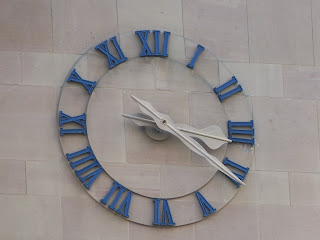We are in city centre for Parts 3 and 4 of this tour. Our starting point today is George Hudson Street off Micklegate.
On what is now a Chinese Buffet restaurant (which I guess just might not have been its original use) is this splendid clock by GJF Newey of York (the family clock making business was founded by George Newey in the 1880s).
Around the corner on Station Rise is the newer office building of Aviva. Although actually quite large, the clock is somewhat lost on the large plain facade of the tower. It is also rather unusual in that most clocks fitted directly onto the walls of newer buildings tend to be modern in design i.e. quite minimalistic. Not only does this one have traditional Roman numerals, but look at those hands - a copy of much older designs.
Moving northwards, we come to Lendal Bridge, the northern most of the three road crossings of the River Ouse in the city centre.
The building on the northern bank is rather fine, but unfortunately the same cannot be said for the state of its clock.
The De Grey Rooms are in St Leonard's Place. This lovely clock is another example by Newey of York. It was commissioned in 1906 for a conference held by the British Association for the Advancement of Science in what is now the art galley (opposite the De Grey Rooms). It was then housed on the Newey workshops on High Petergate, before being moved to its current location.
The centrepiece of the city is of course York Minster, an architectural tour-de-force whose nave originates from 1291, with various other parts added and amended over the centuries.
Inside there are two clock, both of which are in the North Transept (the transept is the bit that goes across the main body of the building - the nave - at right angles).
It is the backdrop and overall setting that truly makes this clock a sight to behold, but the hands are pretty fancy too.
It was made in 1750 by Henry Hindley. Henry (1701 - 1771) was a clock maker originally from Wigan, moving to York in 1731.
Nearby is the Astronomical Clock which commemorates those who died in the Second World War flying for the Royal Air Forces of the Commonwealth and their allies. It was dedicated by the Duke of Edinburgh in 1955 (and it feels appropriate to be writing about this clock on 11th November).
Full details can be found in a booklet produced by the Dean and Chapter of York ("The Astronomical Clock - A Memorial to Fallen Airmen 1939 - 1945". But it includes the constellations by which the aircrew navigated on their missions.
Opposite the Minster, in Minster Gates, is a clock funded by the Rotary Club of York in 1971.
Minster Gates leads back into the main shopping area, which is explored in Part 4.


















No comments:
Post a Comment